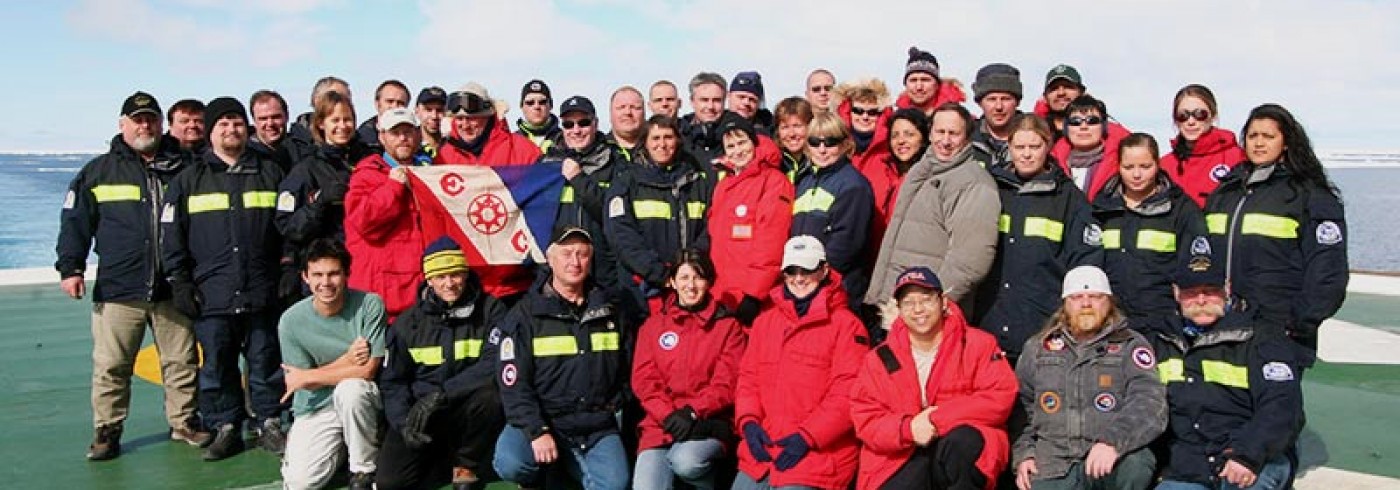Variability of the carbon dioxide system, oxygen and biogeochemical processes in the Southern Ocean
5 December 2006 - 25 December 2006
Time series of 1-minute data from 17 to 21 December 2006 for partial pressure of carbon dioxide (pCO2, ppm), dissolved oxygen (O2, μmol/kg) and chlorophyll-a fluorescence (Chl a, μg/l). Special features (phytoplankton bloom and upwelling) are indicated with circles. The photo (by Agneta Fransson) shows a crabeater seal on an ice flow in the suggested upwelling region.
The aim of this project is to study the effect of sea ice on the carbon dioxide (CO2) system and dissolved oxygen in the surface waters of the Southern Ocean as well as the biogeochemical processes that drive this system during the productive summer season. The ocean fronts, the marginal ice zone, and the ice edge constitute interesting areas of study because of the relatively high level of biological production, resulting in high biological CO2 uptake. As a result of variations in sea-ice cover, caused by the production and melting of sea-ice, a variable environment is created for biological production and CO2 fluxes. The CO2 gas exchange between sea and atmosphere (sea–air) is estimated and related to the physical and biological characteristics of the surface water. Furthermore, the importance of sea ice for CO2 fluxes in the sea–ice–air interface will be investigated.
Background
Variation in extension of The Southern Ocean sea ice cover is largely attributed to melting in summer and freezing again in winter. The seasonality in sea ice conditions affects biological production and CO2 fluxes. Due to the sea ice melt in spring and summer, strong surface water stratification is created, and in combination with nutrient availability and sufficient light, biological CO2 drawdown will take place. Previously, sea ice has been considered to act as a protecting lid, preventing gas exchange between water and atmosphere. However, recent studies have indicated that sea ice is permeable to gases.
Ship-based work
Measurements commenced soon after departing the Strait of Magellan in the austral summer 2006 and proceeded successfully onboard icebreaker Oden both in open water and in sea ice until the McMurdo Sound. The project used on-line, high-frequency measurements of surface water partial pressure of CO2 (pCO2), dissolved oxygen, chlorophyll fluorescence (in collaboration with Dr. M. Chierici), salinity and temperature. Samples for total dissolved inorganic carbon (DIC), total alkalinity (AT) and nutrients (phosphate, nitrate, silicate) were collected and measured on shore (picture 1). This project is closely coordinated with Dr. Chierici’s project.
The automated pCO2 instrument was successfully used for sea ice conditions for the first time in the Arctic expedition Beringia 2005, and was now used for measurements in the Southern Ocean. Seawater was pumped with a flow rate of approx. 15 l/min into a CO2 equilibrator (tandem type combined with a static mixer type manufactured by Kimoto Electric Co., LTD (Kimoto and Harashima 1993, Harashima et al., 1997), passing through a thermosalinograph for continuous pCO2 measurements. The mole fraction of CO2 (xCO2) in dry air, expressed by part per million (ppm), was continuously measured every minute by a non-dispersive infrared detector (NDIR, LiCOR®, model 6262, Lincoln, USA). Four CO2 standard gases and zero gas (0, 250, 350, 450, 550 μatm) were used for calibration and pCO2 in air was alternately measured with the same instrument. Sea surface salinity and temperature were continuously measured and an oxygen sensor (Aanderaa) was used to measure dissolved oxygen every minute. The oxygen values were compared to the values obtained from the discrete samples analysed with the Winkler method.
Preliminary results
Along the sailing route, from open water to marginal sea ice, variability in surface water pCO2 and oxygen was observed using 1-minute readings (figure 1). Preliminary analyses indicate that there was a substantial decline in pCO2 and increase in oxygen (figure 1) and correlative peaks in chlorophyll a (Chl a) on the 17 and 18 December, suggesting that the ship passed through a phytoplankton bloom. The most striking feature was the high pCO2 values, i.e. CO2 oversaturation relative to the atmospheric level, observed for the first time since departing from Punta Arenas. It is probable that this was due to vertical mixing of CO2-rich subsurface water with the surface, which is confirmed by the low oxygen values. The Chl a showed the lowest values during the time period, indicating low primary production. Coincident with this specific time point, the ship also passed through an area of pack ice and moderate densities of Crabeater seals and Adelie penguins which are feeding on zooplankton, which in turn feed on phytoplankton living under the sea ice. In general, pCO2 was below atmospheric values, and the lowest pCO2 values in combination with the highest oxygen and Chl a values were measured in the Ross Sea polynya, implying intense biological CO2 drawdown.


